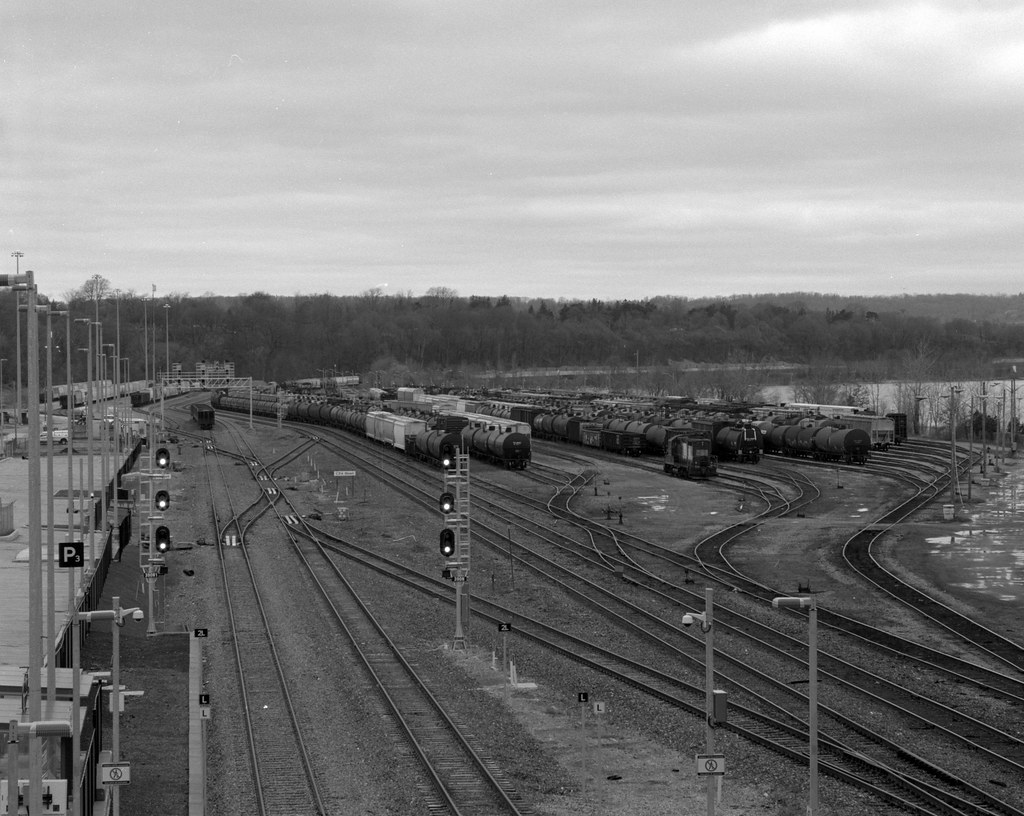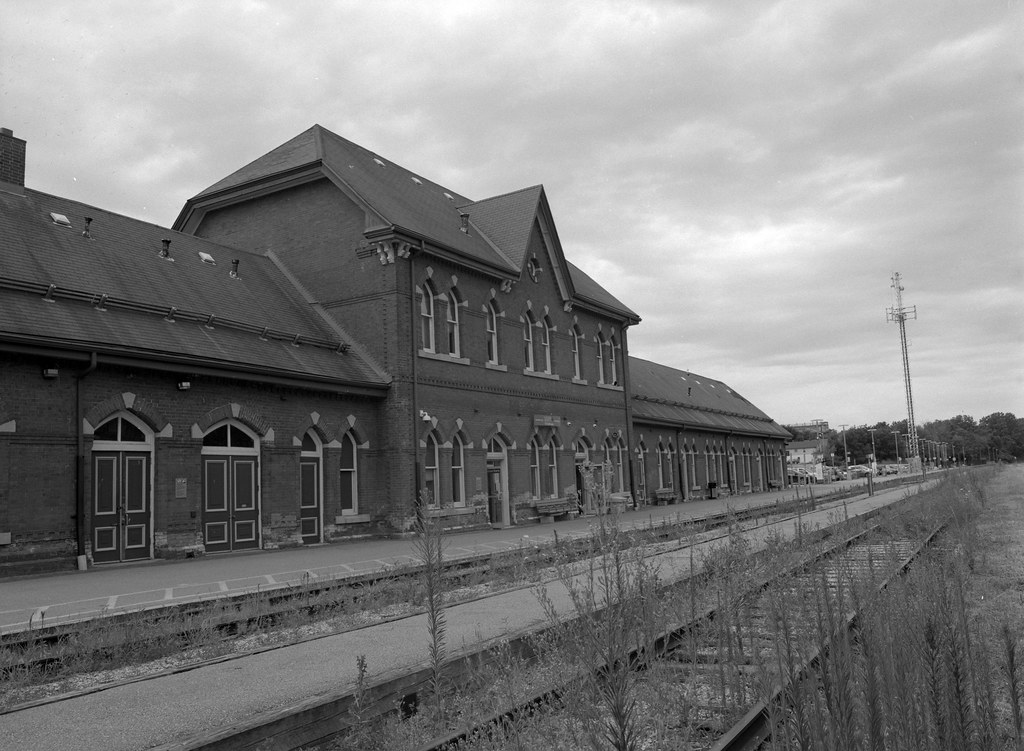Like Ontario, Simcoe & Huron, unless you’re a hardcore railroad history fan, you may have never heard of the Great Western Railroad. If you commute between Hamilton and Toronto on the GO Train, you’ve ridden on the part of the original line for Great Western. Their stations are still in use around the province, and yet the name is long lost to history. Great Western Railroad got its start in 1834 as the London & Gore Railway to build a railway between the city of London and the city of Hamilton. Even in 1834, Sir Allan Napier MacNab invested heavily in the company. But the project never got off the ground. MacNab quickly found himself in the backseat to Samuel Zimmerman who rechartered London & Gore as Great Western Railway in 1845. With the new charter came a new goal and route. Chief Engineer Roswell Benedict laid out the plan to run a line between Windsor and Niagara Falls, with the main headquarters in Brantford. But MacNab still pulled strings as he brought on board a lot of money from British investors. The headquarters and main yard began construction in Hamilton, with MacNab selling off a part of his grand estate on which to build the yard and headquarters. But if anyone considered GWR a Canadian railroad they were deluded, the British were the ones holding all the shares. But it wasn’t just business investors from England. MacNab hoped that the route would attract American business, showing the GWR as an inexpensive way to move cargo by routing it through Canada.

Mamiya m645 – Mamiya-Sekor C 150mm 1:3.5 N – Ilford FP4+ @ ASA-100 – Kodak D-23 (Stock) 6:00 @ 20C
The massive investment from England combined with government money through the passage of the Railroad Act allowed construction to begin in 1951. Speed was the ultimate goal, spurred on by the investors who were eager to turn a quick profit. Thankfully the geography made construction easy. GWR came in second with the initial route seeing completion in 1854. A grand celebration shut down the city of Hamilton on the 17th of January 1854, parades, music, and fireworks were all contrasted against the board, forcing out MacNab. MacNab held out for more money, even promising to use his power as Premiere to help the company out all while courting their direct competitor, Grand Trunk. Even during the initial construction, GWR saw the need to expand, but not wanting to spend the money to build the branches directly. Like Grand Trunk, GWR expanded through purchase. The first small company to fall was in 1855 with the purchase of the Hamilton & Toronto Railroad, providing further reach to Canada West’s other major population centre. They linked their line up to a small railroad connected to the Welland Canal. But the most significant feat would be the completion of the Niagara Suspension Bridge on the 18th of March, 1855. The Bridge project had been spurred on by William Hamilton Merritt to construct a suspension bridge. Many said such a feat could not be completed, and it did see some initial trouble in getting that first cable across the gorge until one man used a kite and after several attempts made it across. Construction moved forward with massive limestone towers and wooden decking and supports quickly crossed, providing the first cross-border bridge that provided near-seamless rail travel across the border.

Mamiya m645 – Mamiya-Sekor C 45mm 1:2.8 N – Ilford FP4+ @ ASA-100 – Kodak D-23 (Stock) 6:00 @ 20C
Mamiya m645 – Mamiya-Sekor C 45mm 1:2.8 N – Ilford FP4+ @ ASA-100 – Kodak D-23 (Stock) 6:00 @ 20C
It was clear that Grand Trunk and GWR stood toe-to-toe and would jockey for supremacy. But soon the rapid build-up came back to bite GWR, in the darkness of the 12th of March 1857 the six o’clock train from Toronto took the curve approaching the Desjardin Canal Bridge. It was a route well-travelled and often travelled by many trains, but as it came out of the curve, a strange noise could be heard by the train’s passengers. What no one realised is that one of the locomotive’s axles had broken and the train was partially derailed. The off-the-rails train hit the bridge, the poor quality of decking along with the weight and derailment the decking gave way sending the locomotive, tender and several cars into the frozen canal below. When the train failed to arrive on schedule, those at the Hamilton station began to search moving out from the station along the tracks. Police, Fire, even local citizens were not prepared for what they found, the train appeared to be more like some ancient monster rising from the water. Some survived, many did not. The station became a gruesome scene as the bodies were laid out for identification among the dead, GWRs own Samuel Zimmerman and the son of the city’s mayor. The mayor went on to describe the date as a day of humiliation. But GWR did not let the accident stop them; instead, it spurred them into action. GWR began the long process of replacing the original iron rails with that made from steel, to control production GWR opened the city’s first steel mill. Also, in the process, they changed the gauge of the network to American standard. They also constructed a grand train station in Toronto which opened in 1860 and five years later the upgraded rails were complete. GWR rode high again, commanding a network of nearly 1,400 kilometres of track.

Mamiya m645 – Mamiya-Sekor C 35mm 1:3.5 N – Ilford FP4+ @ ASA-100 – Kodak D-23 (Stock) 6:00 @ 20C
Mamiya m645 – Mamiya-Sekor C 150mm 1:3.5 N – Ilford FP4+ @ ASA-100 – Kodak D-23 (Stock) 6:00 @ 20C
But now both Grand Trunk and Great Western were nipping at each other’s territory. But it would be the economic crash of 1873 that nearly did GWR in. The investors clamoured as the price of their shares plummeted. Municipalities and regular shareholders in Canada began to sell off their holdings in panic, and the British investors hoped for a turn around scooped them up at a discount. With the board under total British control, they decided to put their own man in charge in 1874, H.C.E. Childers. Childers began a campaign of radical changes, heading up the slash and burn tactic was Childers’ manager Fredrick Boroughs. Within five years, the GWR was profitable once more. And the few remaining shareholders and employees began to resent their British bosses. And despite all the cuts the railroad continued to fall deeper and deeper, the remaining Canadian shareholders clamoured for a takeover. Smelling blood, the new president of Grand Trunk, began to make offers. The British shareholders decided to cut their losses and sold majority control to Grand Trunk on the 12th of August 1882. Unlike other takeovers, Grand Trunk continued to operate the line under the GWR banner. Stations rebuilt and infrastructure improved. When Grand Trunk faced its final financial difficulty in 1923, everything, including Great Western fell under the new Canadain National Railway. The ultimate end of Great Western was the demolition of the original GWR Headquarters and Station in Hamilton in the late 1920s.

Mamiya m645 – Mamiya-Sekor C 45mm 1:2.8 N – Ilford FP4+ @ ASA-100 – Kodak D-23 (Stock) 6:00 @ 20C
Mamiya m645 – Mamiya-Sekor C 45mm 1:2.8 N – Ilford FP4+ @ ASA-100 – Kodak D-23 (Stock) 6:00 @ 20C
Today much of the original Great Western network continues to operate under the control of Canadian National. The original route from Niagara Falls to Windsor serves as the Grimsby, Dundas, Chatham, and CASO sub-divisions. The Toronto to Hamilton line runs as the Oakville sub-division and sees daily use with GO Transit customers. The original Great Western Yard continues to operate in Hamilton, Ontario. Some Great Western stations still stand, notably is the Bridge Street Station in Niagara Falls, Ontario. Built in 1879 after the original station burned down is a fantastic example of Victorian Era train station architecture. It saw extensive restoration in the 1930s ahead of the royal visit of King George VI and Queen Elizabeth (The Queen Mother). Today it serves both VIA Rail and GO Transit, retaining much of the original interior and exterior detailing. Grand Trunk would also rebuild the GWR stations in Woodstock (1886) and Ingersoll (1885), today the Woodstock Station still operates after extensive restoration in 1986 as a VIA rail station. The Ingersoll station is not so lucky having been abandoned by CN in 1979, rather than restore the station VIA built a smaller station next to it. There are no remains of the original Niagara suspension bridge, having been replaced by the Whirlpool Bridge in the late 19th-Century which still operates as both a rail and vehicle bridge on the Niagara river, vehicles are only allowed across under the NEXUS program. The original supports of the Desjardin Canal bridge still stand although the decking has been replaced several times. While the site of the disaster is not marked, a memorial to the disaster stands in the Hamilton Municipal Cemetery although it is hard to spot as the locomotive that once stood atop it has been knocked off. The greatest legacy of Great Western remains the fact it put the city of Hamilton on the map, both as a significant urban centre in Canada West but as an industrial powerhouse. A status that held well into the late 20th-Century, and while not as big as it once was the steel mills along Burlington Bay still hold that legacy into today.
1 Comment